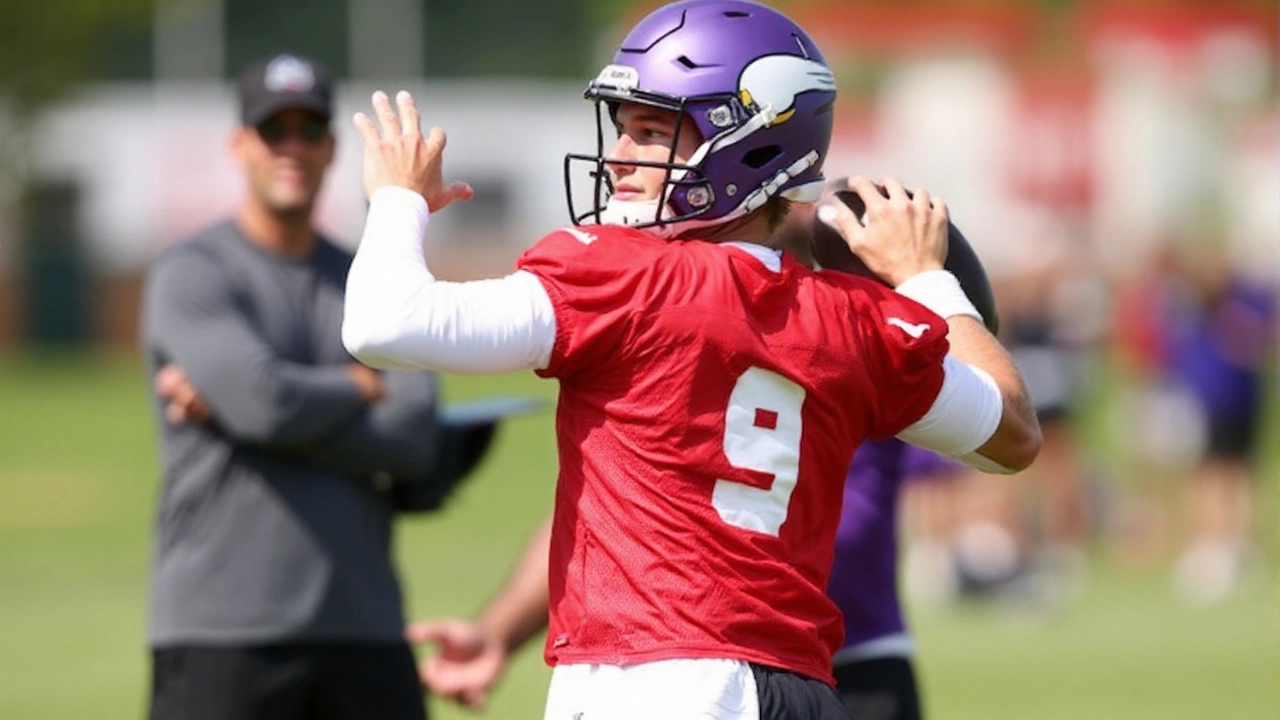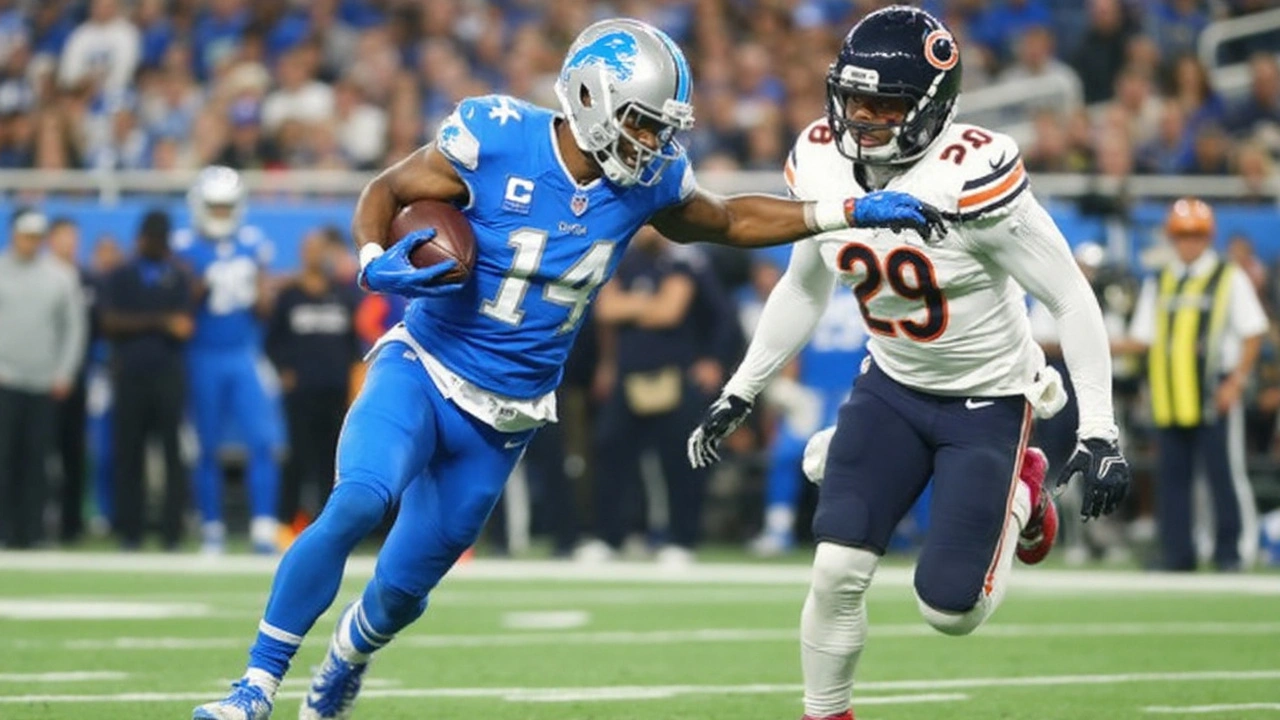Goff and St. Brown light up Ford Field as Lions bury Bears
The scoreboard told the whole story. The Detroit Lions put up 52 points on the Chicago Bears and never came off the gas, winning 52-21 at Ford Field in Week 2. Jared Goff carved up Chicago’s secondary, Amon-Ra St. Brown owned the red zone, and Detroit’s defense made a rookie quarterback look exactly like that—promising, dangerous, and not ready to carry a team on the road.
Goff’s line was the stuff of efficiency drills: 23 completions on 28 throws, 334 yards, five touchdowns, and not much in the way of stress. When he needed a drive-saver, St. Brown was there, finishing with nine catches for 115 yards and three scores. Jameson Williams stretched the field and forced safeties to play honest, while Jahmyr Gibbs balanced it out with 12 carries for 94 yards and a touchdown. Detroit didn’t just move the ball. It controlled the situation, the tempo, and the mood inside the building.
This was supposed to be a test of how Detroit would respond after a flat season opener. It turned into a showcase. The Lions went up 14-7 in the first quarter and never looked back, unloading a 24-0 run that flipped a divisional game into a clinic. A quirky clock moment late in the half even helped them pile on—six seconds were added after time appeared to run out, and Dan Campbell had to call his players back from the tunnel for another snap. Detroit turned that extra shot into more points and a deeper hole for Chicago.
For the Bears, the day was about flashes and growing pains. No. 1 pick Caleb Williams hit some beautiful throws, especially to fellow rookie Rome Odunze, who went for seven catches, 128 yards, and both of Chicago’s passing touchdowns. Williams also forced one ball he’d want back, got intercepted, and later watched the finish from the sideline as the Bears protected the long game. His postgame tone was exactly what you want from a young quarterback after a bruising lesson: “You always point the finger at yourself before you point a finger at anybody else.”
Chicago’s problems weren’t isolated to the pocket. The Bears were sloppy, flagged eight times, turned it over on downs in both halves, and let the pass rush get home four times. D’Andre Swift managed 63 rushing yards and a short touchdown in his first game back in Detroit as a visitor, but the run game never took control. Too many second-and-longs and third-and-obvious passes left Williams picking through heavy traffic against a defense that smelled it coming.
Detroit’s defense didn’t steal the show like the offense, but it did its job with force. The front collapsed the pocket at key moments, the linebackers took away easy outlets, and the back end limited explosive plays to the Odunze connection. The pick of Williams, plus those fourth-down stands, were tone-setters—every one of them a gut punch to a Chicago sideline that struggled to steady itself.
What stood out most about the Lions’ offense was the ease of the operation. Goff stayed clean, found favorable matchups, and trusted his guys to win at the top of routes. St. Brown was the matchup problem the Bears never solved. Line him up in the slot, motion him into leverage, or use him on quick hitters—Chicago had no consistent answer. When the defense tightened, Detroit leaned into play-action and its backs. Gibbs’ burst showed up on the edges, and David Montgomery’s downhill style kept the chains moving even when the box got heavier.
Credit the Lions’ line for making all of that click. The pockets were firm, the run lanes were on time, and any pressure that did arrive felt late. That’s how you assemble a five-touchdown passing day without living on desperation throws. It also helps when your play-calling keeps the defense off balance—screens, quick-game, shot plays, and gap runs all sprinkled in without obvious patterns.
The clock episode right before halftime won’t be the headline, but it was revealing. Campbell initially waved his team off as time appeared gone, then hustled them back when six seconds were restored. On a day full of rhythm and control, that sequence showed command in the margins—organization on the sideline, awareness from the staff, and players ready to execute on short notice. Chicago, by contrast, looked rattled by the swing and never really recovered.
The raw numbers tell a blunt story: 52 points by Detroit, three off the franchise regular-season record. The 52 yielded by Chicago were three shy of matching the most allowed in the club’s long history. The Bears are 0-2 and have now dropped 12 of their last 13 going back to previous seasons. The Lions are 1-1 and 1-0 at home, with the building again feeling like a place where opponents tread carefully.
Zoom out, and the game fit two arcs. Detroit looked like last year’s explosive outfit, the one that diced up coverages and buried teams with balance. Chicago looked like a team transitioning to a rookie quarterback and paying the tax—penalties at bad moments, protection breakdowns, and a defense that can’t get off the field often enough to flip momentum.
Williams’ connection with Odunze, though, is real. The 28-yard strike that answered Detroit’s opener had touch and timing, and the 6-yard red-zone throw late in the first half cut it to 21-14, keeping the Bears within reach. In between those plays, the Bears’ offense struggled to string together clean sequences. The rookie quarterback can deal; the structure around him must be steadier if Chicago wants sustainable drives against top-10 offenses.
Detroit’s improvements showed up in all the small places coaches obsess over. Pre-snap motion didn’t produce chaos; it produced answers. Goff’s eyes moved defenders. The receivers finished plays through contact. And when the Lions got into the low red zone, they didn’t settle—St. Brown’s third touchdown summed up that decisiveness: find leverage, win the release, finish the catch. Simple, ruthless football.
Chicago’s defense had two consistent problems. First, it couldn’t take away the first read often enough. Second, it didn’t close the deal in the pass rush. You can’t let a veteran quarterback live on schedule and expect anything but pain. The Bears mixed pressures and coverages, but Detroit’s protections and spacing kept the rush a step late and the coverage a beat slow.
Both coaches managed the final quarter like a blowout. Goff, Williams, and several starters watched from the sideline, the Lions protecting their health and the Bears protecting their quarterback from empty calories behind a tired line. By then, the football was about reps for depth players and tape for teaching.

What decided it—and what it means next
Here’s what swung the game and why it matters for both teams moving forward.
- Early control: Detroit’s first-quarter edge (14-7) forced Chicago into chase mode. From there, the Lions layered in tempo and balance, and the Bears could not dictate terms on defense.
- Explosives plus balance: St. Brown and Jameson Williams stretched Chicago horizontally and vertically. Gibbs punished light boxes and got the perimeter yards that keep a playbook wide open.
- Situational football: Detroit was sharper on fourth downs and in the low red zone. Chicago’s two turnovers on downs and eight penalties stalled any hint of momentum.
- Pass rush timing: The Lions’ four sacks didn’t just pad the stat sheet; they arrived on drives where Chicago needed clean pockets to stay attached. Those negative plays broke the script for a rookie QB.
- Discipline and execution: One team had both for four quarters. The other had spurts and mistakes. That’s the difference between a comfortable home win and searching for answers on the flight back.
For Detroit, the film will show a quarterback synced with his play-caller, a receiver room that separates, and a backfield that can tilt games without emptying the clip. If the defense keeps turning pressure into drive-killing plays, this is the NFC North favorite many expected to see.
For Chicago, the priorities are clear and fixable: cut the penalties, protect the quarterback better on long downs, and give Williams more layups on early downs. Odunze looks like a day-one problem for defenses. Swift can carry volume when the game stays neutral. The big question is whether the offensive line and the defensive front can steady the middle of the field long enough for the rookies to swing games late.
There’s no panic in September, but context matters. The Bears are 0-2 with both games exposing the same issues—discipline, protection, and explosive plays allowed. The Lions are 1-1 and already reclaiming the identity that drove last year’s surge: physical on the line, creative with the ball, and confident in big moments.
Detroit leaves Week 2 with a highlight reel, a loud building, and a clear template for how it wants to win. Chicago leaves with teachable tape, a quarterback who owns his part, and the hard truth that the details must sharpen fast in a division that doesn’t give you time to figure it out.

Write a comment